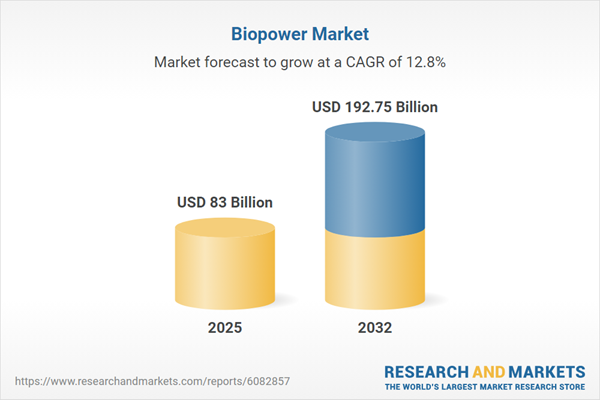Speak directly to the analyst to clarify any post sales queries you may have.
The biopower market is gaining momentum as global clean energy ambitions rise. Senior executives are now prioritizing biopower not just for electricity generation, but also as a catalyst for sustainable waste valorization and supply chain modernization.
Market Snapshot: Biopower Market Growth and Dynamics
The Biopower Market grew from USD 73.75 billion in 2024 to USD 83 billion in 2025 and is projected to maintain robust growth at a CAGR of 12.75%, reaching USD 192.75 billion by 2032. This expansion reflects a convergence of regulatory drivers, rapid technology improvements, and evolving stakeholder requirements for decarbonization, efficient resource management, and reliable energy delivery.
Scope & Segmentation of the Global Biopower Market
Senior decision-makers will benefit from strategic analysis across these critical segments:
- Technology: Anaerobic Digestion, Co-firing, Combustion, Gasification, Pyrolysis
- Feedstock Type: Agricultural Waste, Animal Manure, Energy Crops, Forestry Residues, Industrial Waste, Organic Municipal Solid Waste
- End User: Combined Heat and Power, Heat Generation, Power Generation
- Application: Commercial, Industrial, Residential
- Region: Americas (North America: United States, Canada, Mexico; Latin America: Brazil, Argentina, Chile, Colombia, Peru), Europe, Middle East & Africa (Europe: United Kingdom, Germany, France, Russia, Italy, Spain, Netherlands, Sweden, Poland, Switzerland; Middle East: United Arab Emirates, Saudi Arabia, Qatar, Turkey, Israel; Africa: South Africa, Nigeria, Egypt, Kenya), Asia-Pacific (China, India, Japan, Australia, South Korea, Indonesia, Thailand, Malaysia, Singapore, Taiwan)
- Key Players: Veolia Environnement S.A., ENGIE S.A., RWE AG, Drax Group plc, E.ON SE, Enel S.p.A., Fortum Oyj, Ørsted A/S, Covanta Holding Corporation, Statkraft AS
Key Takeaways for Senior Decision-Makers
- Global energy transition policies are advancing biopower adoption through direct incentives, sustainability mandates, and regional market support.
- Major breakthroughs in digestion, gasification, and digital operational platforms are driving system efficiency, reliability, and flexible integration with existing infrastructure.
- Feedstock diversification—including agricultural residues, municipal waste, and energy crops—enables resilience in sourcing and supports new value chains.
- Competitive dynamics are shifting, with industry leaders focusing on strategic partnerships, modular plant investments, and digital asset monitoring.
- Market opportunities are regionally nuanced, highlighting the importance of localization, supply chain strategies, and tailored technology deployment to match available resources and policy frameworks.
Tariff Impact: Navigating Cost and Supply Chain Pressures in 2025
Recent US tariff measures redefined project finance and sourcing strategies throughout the biopower sector. Elevated duties on imported equipment prompted a strategic shift toward domestic manufacturing and diversified procurement. This led to adaptive partnerships with regional suppliers and accelerated supply chain localization, reshaping cost structures and investment planning for developers and operators.
Methodology & Data Sources
This report is grounded in an integrated research approach encompassing in-depth interviews with industry and policy leaders, analysis of authoritative databases, and validation through cross-verification. Rigor is maintained via expert review panels and statistical reliability checks to ensure actionable, unbiased findings for executive decisions.
Why This Report Matters to Senior Executives
Decision-makers will:
- Access direct, segment-level intelligence for competitive positioning and investment prioritization in a shifting biopower landscape.
- Gain clarity on regulatory drivers, technology trends, and evolving stakeholder expectations that inform sustainable business strategies.
- Understand regional growth patterns, supply chain pressures, and financing approaches integral to resilient market navigation.
Conclusion
The biopower sector is at a strategic inflection point. Senior executives equipped with actionable insights and robust market intelligence will effectively harness emerging biopower opportunities and address sector-specific risks in this evolving energy paradigm.
Table of Contents
3. Executive Summary
4. Market Overview
7. Cumulative Impact of Artificial Intelligence 2025
Companies Mentioned
The companies profiled in this Biopower market report include:- Veolia Environnement S.A.
- ENGIE S.A.
- RWE AG
- Drax Group plc
- E.ON SE
- Enel S.p.A.
- Fortum Oyj
- Ørsted A/S
- Covanta Holding Corporation
- Statkraft AS
Table Information
| Report Attribute | Details |
|---|---|
| No. of Pages | 189 |
| Published | October 2025 |
| Forecast Period | 2025 - 2032 |
| Estimated Market Value ( USD | $ 83 Billion |
| Forecasted Market Value ( USD | $ 192.75 Billion |
| Compound Annual Growth Rate | 12.7% |
| Regions Covered | Global |
| No. of Companies Mentioned | 11 |









